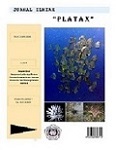Application Of Pes Fertilizer To The Growth Of Kappaphycus alvarezii Plantlets
DOI:
https://doi.org/10.35800/jip.v11i2.50619Keywords:
growth;, Kappaphycus alvarezii;, plantlets;, PES fertilizer;, dosage;Abstract
This study aims to determine the growth of Kappaphycus alvarezii plantlets applied with different PES fertilizers. This research was conducted at Blitok Installation, brackish water aquaculture center, Situbondo. This study began with the preparation of water as a maintenance medium, acclimatization of plantlets in the greenhouse, maintenance of plantlets in the greenhouse (plantlet cleaning, fertilization), and checking water quality. The application dose of PES fertilizer given as treatment was 15 ml, 20 ml, and 25 ml which was repeated 3 times. The rearing design used a completely randomized design (CRD) model. The results obtained showed that the average absolute weight gain of planlets from the 15 ml treatment was 0.249 g - 0.271 g, the 20 ml treatment was 0.35 g - 0.432 g, and the 25 ml treatment ranged from 0.306 g - 0.372 g. For the specific growth rate from the first to the fifth week of rearing, the 15 ml treatment ranged from 3.162-1.693, the 20 ml treatment ranged from 3.922-4.21 and the 25 ml treatment ranged from 2.899-3.904. From the results of the study, it can be concluded that the application of a PES fertilizer dosage of 20 ml gave better growth than the 15 ml and 25 ml doses.
Keywords: growth, Kappaphycus alvarezii, plantlets, PES fertilizer, dosage
References
Effendie, M.I. 1997. Biologi perikanan. Yayasan Pustaka Nusatama. Yogyakarta
FAO. 2022. The state of world fisheries and aquaulture (SOFIA): Towards blue tranformation. FAO. Rome, Italy. 266p.
Karim S. S. (2019). Pengaruh salinitas dan dosis pupuk PES (Provasoli's Enrich Seawater) yang berbeda terhadap induksi kalus alga laut Kappaphycus alvarezii. Skripsi, 1(1111415071).
KKP. 2018. Rumput laut, komoditas penting yang belum dioptimalkan. Jakarta. https://kkp.go.id/djpdspkp/bbp2hp/artikel/14127-rumput-laut-komoditas-penting-yang-belum-dioptimalkan
Mairh, O. P., Soe-Htun, U., & Ohno, M. (1986). Culture of Eucheuma striatum (Rhodophyta, Solieriaceae) in sub-tropical waters of Shikoku, Japan.
Nurfebriani, D. N., Rejeki, S., & Widowati, L. L. (2015). Pengaruh pemberian pupuk organik cair dengan lama perendaman yang berbeda terhadap pertumbuhan rumput laut (Caulerpa lentillifera). Journal of Aquaculture Management and Technology, 4(4), 88-94. https://ejournal3.undip.ac.id/index.php/jamt/article/view/10054.
Nursyahran dan Reskiati. (2013). Peningkatan laju pertumbuhan thallus rumput laut (Kappaphycus alvarezii) yang direndam air beras dengan konsentrasi yang berbeda. Jurnal Balik Diwa Volume 4 Nomor 2 Juli-Desember 2013. https://adoc.pub/peningkatan-laju-pertumbuhan-thallus-rumput-laut.html.
Nurfajri, A. T. & Nasmia, N. (2023). Penggunaan pupuk conway pada media kultur terhadap pertumbuhan bibit rumput laut Eucheuma cottonii. Journal of Marine Research, 12(1), 19-26. https://doi.org/10.14710/jmr.v12i1.35769.
Pillay, T. V. R. (1990). Aquaculture: principles and practices. fishing news books.
Prabowo, B. H., Kurnianto, D., Aprilia, I. R., & Amilia, S. (2021). The development and potential of seaweed tissue culture. Indonesian Journal of Biology Education, 4(2), 7-13. DOI: 10.31002/ijobe.v4i2.4075.
Rosyida, E., Tobigo, D. T., & Setiana, S. (2019). Growth of Eucheuma cottonii seaweed from tissue culture in PES fertilizer solution (provasoli enriched seawater) with different dose. AgriSains, 20(3), 133-143.
Ruslaini, R. (2016). Kajian kualitas air terhadap pertumbuhan rumput laut (Gracilaria verrucosa) di tambak dengan metode vertikultur. OCTOPUS: JURNAL ILMU PERIKANAN, 5(2), 522-527. https://doi.org/10.26618/octopus.v5i2.724.
Sahoo, D., & Yarish, C. (2005). Mariculture of Seaweeds in Algal Culturing Tecniques eds RA Andersen.
Sulistiawati, D., Cokrowati, N., & Widiyanti, L. (2015). Optimalisasi kepadatan bibit Eucheuma cottonii hasil kultur jaringan pada tahap pemeliharaan dibotol aerasi. Skripsi. Universitas Mataram.
Supriyono, E., Hastuti, Y. P., & Arifka, A. R. (2022). Combination effect of atonic growth regulator with PES (Provasoli Enrich Seawater) on Seaweed (Eucheuma cottonii) growth. In IOP Conference Series: Earth and Environmental Science (Vol. 1033, No. 1, p. 012019). IOP Publishing.
Suryati, E., A. Tenriolu dan B.R Tampangalo, 2010. Laporan Penelitian. Pelestarian plasma nutfah rumput laut Kappaphycus alvarezii (Doty) melalui induksi kalus dan embriogenesis secara in vitro. Balai riset perikanan budidaya air payau pusat riset perikanan budidaya kementrian kelautan dan perikanan. 25 hal.
Susilowati, T., Rejeki, S., Zulfitriani, Z., & Dewi, E. N. (2012). The influence of depth of plantation to the growth rate of Eucheuma cottonii seaweed cultivated by longline method in Mlonggo beach, Jepara Regency. SAINTEK PERIKANAN: Indonesian Journal of Fisheries Science and Technology, 8(1), 7-12. https://doi.org/10.14710/ijfst.8.1.7-12.
Togatorop, A. P., Dirgayusa, I. G. N. P., & Puspitha, N. L. P. R. (2017). Studi pertumbuhan rumput laut jenis kotoni (Eucheuma cottonii) dengan menggunakan metode kurung dasar dan lepas dasar di Perairan Geger, Bali. Journal of Marine and Aquatic Sciences, 3(1), 47-58. https://doi.org/10.24843/jmas.2017.v3.i01.47-58.
Yuliana, Y. (2013). Pengaruh perendaman Eucheuma spinosum J. Agardh dalam larutan pupuk provasoli’s enrich seawater terhadap laju pertumbuhan secara in vitro (Doctoral dissertation, Universitas Hasanuddin).
Yuniarti, L. S., Sri, A., Happy, N., & Muhammad, F. (2018). Concentration of liquid pes media on the growth and photosynthetic pigments of seaweeds Cotonii propagule (Kappaphycus alvarezii Doty) through tissue culture. Russian Journal of Agricultural and Socio-Economic Sciences, 75(3), 133-144.
Yusran, Y., Cinnawara, H. T., & Syarifuddin, M. (2021). Laju Pertumbuhan Rumput Laut Eucheuma cottoni dengan bobot bibit berbeda menggunakan jaring trawl dan long line. Fisheries of Wallacea Journal, 2(1), 10-19. https://dx.doi.org/10.55113/fwj.v2i1.630.
Downloads
Published
How to Cite
Issue
Section
License
Copyright (c) 2023 Dzikri Wahyudi, Chrisoetanto P. Pattirane, Ayu Riyani Marwah, Dony Frederik Sangkia

This work is licensed under a Creative Commons Attribution-NonCommercial 4.0 International License.
COPYRIGHT
Authors who publish with this journal agree to the following terms:
Authors hold their copyright and grant this journal the privilege of first publication, with the work simultaneously licensed under a Creative Commons Attribution License that permits others to impart the work with an acknowledgment of the work's origin and initial publication by this journal.
Authors can enter into separate or additional contractual arrangements for the non-exclusive distribution of the journal's published version of the work (for example, post it to an institutional repository or publish it in a book), with an acknowledgment of its underlying publication in this journal.
Authors are permitted and encouraged to post their work online (for example, in institutional repositories or on their website) as it can lead to productive exchanges, as well as earlier and greater citation of the published work (See The Effect of Open Access).






































